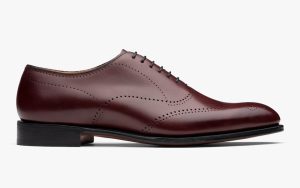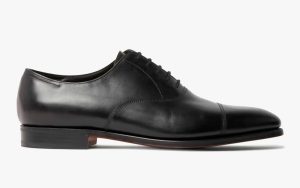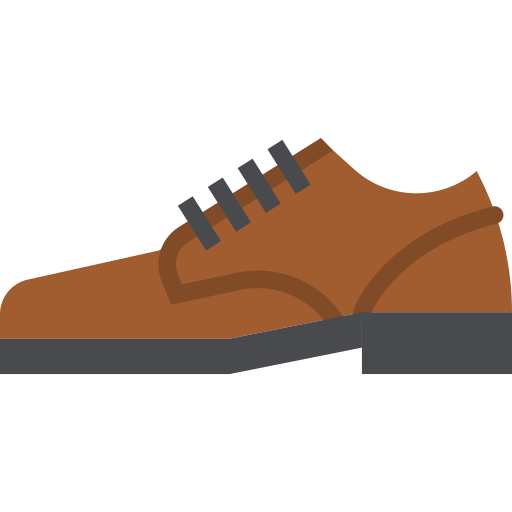The Oxford shoes,best Leather shoes you can get
The characteristic of an Oxford shoe known as “closed lacing” is the shoelace eyelet tabs that are fastened beneath the vamp [1].In comparison, derbys, also known as bluchers, have shoelace eyelets sewn to the top of the vampire.[3] The Oxford shoes were first designed as formal shoes made of leather. Over time, they developed into various styles appropriate for dressy, casual, and uniform settings. Oxfords are now constructed from a range of materials, including calf leather, suede, canvas, and real and fake patent leather, depending on the function and fashion rules. They can be plain or patterned (brogue), often black or brown.

The Oxford shoesTerminology
Geographically, “Oxford” and “balmoral” can have different meanings. In Scotland and the United States, “Oxford” and “Balmoral” are frequently used interchangeably.[4] The term “Oxford” is occasionally used in the US to refer to any more formal lace-up shoe, such as the Derby and Blucher. The Balmoral is an Oxford design that is popular on boots in Britain and other countries. It has no seams other than the toe cap seam that descends to the welt. Oxford shoes are renowned for their elegance and diversity as well. The most popular form of Oxford shoe is the cap-toe model, but other styles that are frequently mentioned include the whole cut, plain toe, and a version on the brogue.[5] Oxfords and Balmorals, which have closed laces, are seen as more formal than Bluchers and Derbys, which have open laces.[6]
The meaning of “Oxford” and “balmoral” may vary geographically. In the UK Britain and other countries, the Balmoral is an Oxford with no seams, apart from the toe cap seam, descending to the welt, a style common on boots. Oxford shoes are also known for their variation or style. The Cap-Toe Oxford is the most well-known, although ‘Whole Cut’, ‘Plain Toe’, and a variation of ‘Brogue’ Oxfords are commonly referred to styles.[5] Shoes with closed lacing (Oxfords/Balmorals) are considered more formal than those with open lacing (Bluchers/Derbys).[6] A particular type of oxford shoe is the whole cut oxford, its upper made from a single piece of leather with only a single seam at the back or in the rare exception no seams at all.[7]
History of The Oxford shoes
Evening Oxford shoes were created by Alfred J. Cammeyer in 1891
Oxfords first appeared in Scotland and Ireland, where they are occasionally called Balmorals after Balmoral Castle. However, the shoes were later named Oxfords after Oxford University. This shoe style did not appear in North America until the 1800s.[8] In the United States, Oxfords are called “Bal-type” as opposed to “Blucher-type”. In France, Oxfords are known as Richelieu.[9]
Oxfords were derived from the Oxonian, a half-boot with side slits that gained popularity at Oxford University in 1800.[10] Unlike early shoes, Oxfords were cut smaller than the foot. The side slit evolved into a side lace that eventually moved to the instep, as students rebelled against knee-high and ankle-high boots. The toe cap can either be lined with two narrow rows of stitching, perforated holes along the end cap stitching (quarter-brogue), perforated holes along the end cap stitching and on the toe cap (semi-brogue), or a semi-brogue with the classical wingtip design (full-brogue).[11]
Shop for The Oxford Shoes for Men Online on Metro Shoes
Get your hands on a range of classic Oxford shoes for men online on Metro Shoes. Our collection ensures you get a timeless silhouette with a modern appeal. Even better, find them at attractive prices and with discounts during sale periods. Now you have all the reasons to add this wardrobe staple to your closet. Sign up to shop with us and have your new footwear shipped soon.
John Lobb City II Leather Oxford Shoes
John Lobb has a reputation for being a tony brand, but its history is (sort of) rooted in functionality. The founder of the brand, John Lobb, walked from Cornwall to London as an apprentice bootmaker in 1851 and then traveled to Australia for the gold rush. He created hollow-heeled booties in which gold nuggets could be hidden by miners. Enterprising! He returned to England and was named bootmaker for the Prince of Wales. Lobb City II Leather Oxford Shoes with their single leather soles, double-stitched toe cap, and 190-step production process demonstrate the brand’s dedication to artisanal techniques. They look great with suits or highly polished tuxedos.

Church’s Masai Leather Oxford Brogue Shoes
Church’s is a must when discussing Oxford and Northampton’s manufacturing. Church has roots in Northampton dating back to 1617. The Church family is passionate about leather and produces a superb Oxford. The word “brogue” is derived from the Gaelic “brog,” which means “rough” or stout. In the 19th Century, Scottish and Irish farmers would wear a version of this style with a distinctive series of punching to drain the boggy, wet conditions of their land. Church’s cordovan Oxfords are a more elevated version of the classic brogue. They are part of their Crown collection and are made from Masai leather.
Date of Brand Origin: 1873.
Colors Available: 2.

Conclusion
In conclusion, Oxford shoes represent a timeless and versatile footwear choice that effortlessly blends sophistication with practicality. Characterized by their closed lacing system, sleek design, and often made from high-quality leather, Oxford shoes have transcended fashion trends to become a staple in both formal and casual wardrobes. Their clean and classic silhouette makes them suitable for various occasions, from professional settings to elegant events. The durability of Oxford shoes, coupled with their adaptability to different styles and outfits, makes them a reliable investment in one’s wardrobe. Whether paired with a tailored suit for a polished business look or dressed down with chinos for a smart-casual ensemble, Oxford shoes exude an enduring sense of refinement. Embracing tradition while remaining contemporary, these shoes continue to be a symbol of sartorial excellence, appealing to individuals who appreciate timeless fashion and craftsmanship.
Download Now

